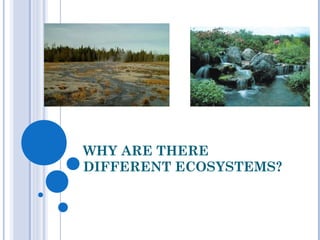
4. why are they so different
- 1. WHY ARE THERE DIFFERENT ECOSYSTEMS?
- 2. LEARNING OBJECTIVE To discover what makes ecosystems different
- 3. THE EARTH’S MAIN ECOSYSTEMS -BIOMES BBC bitesize : Here and Here
- 4. FACTORS AFFECTING BIOMES climate relief geology soils vegetation
- 5. TUNDRA The frozen cold ecosystems found near the northern most parts of the Earth are called tundras by scientists. These locations are known for their long cold winters, and their short cool summers.
- 6. DESERT Desert biomes are found throughout the Earth. These dry locations have specialized plants and animals that have become adapted to surviving on little water. Some plants and animals can actually store water within their bodies, such as cactus, camels, and some varieties of frogs.
- 7. DESERT SCRUB Fast-draining sandy soils in more humid regions. These scrublands are characterized by plants with adaptations to the dry climate, which include small leaves to limit water loss, thorns to protect them from grazing animals, succulent leaves or stems, storage organs to store water, and long taproots to reach groundwater
- 8. GRASSLAND Grassland biomes exist throughout the Earth, and in many cases can be vast, expanding across millions of square miles, or kilometers. These biomes are marked by extensive grasses as well as a variety of small and large animals. Some of the largest land animals on Earth live in grasslands.
- 9. SAVANNAH distinguished by their warmer climate, and seasonal droughts. A Savanna is a rolling grassland scattered with shrubs and isolated trees, which can be found between a tropical rainforest and desert biome
- 10. TUNDRA Tundra is the coldest of all the biomes. It is noted for its frost-molded landscapes, extremely low temperatures, little precipitation, poor nutrients, and short growing seasons.
- 11. RAINFOREST Tropical rain forests are found in locations that receive significant amounts of rainfall. These locations are easily recognizable by their abundance of lifeforms. Including numerous trees, plants such as ferns, and an abundance of insects, spiders, snakes, monkeys, and other plants and animals.
- 12. DECIDUOUS Deciduous" means to fall off, or shed, seasonally. Just as the name implies, these deciduous trees shed their leaves each fall. Lying on the forest floor, the leaves decay. As the leaves decompose, the nutrients contained in the leaves are absorbed by the soil. For this reason, the soils of this biome tend to be very fertile.
- 13. CONIFEROUS FOREST Coniferous forest ecosystems are found in regions of the Earth that experience somewhat long and cold winters, with summer being much shorter. Thus, it is no surprise that these biomes are more common the closer one travels towards the Earth’s poles. Additionally, this biome is found high atop mountains where temperatures tend to be lower and winter tends to last longer.
- 23. TASK: PG 47. Q2 EXERCISE FROM WORKBOOK: P23